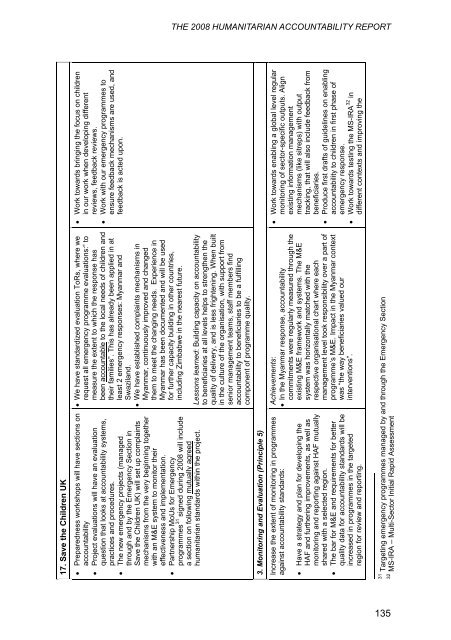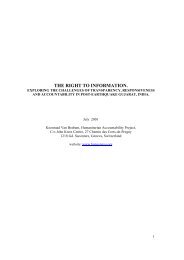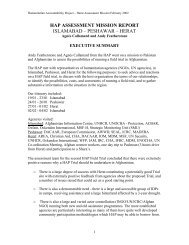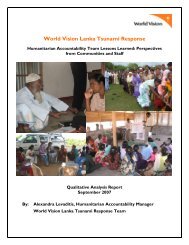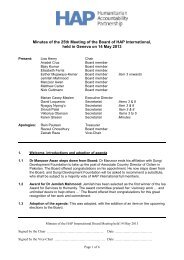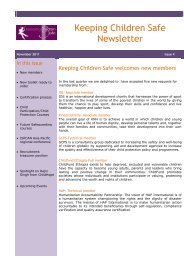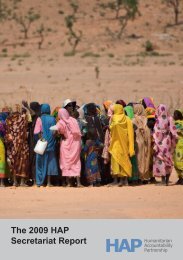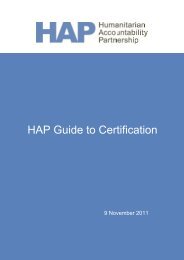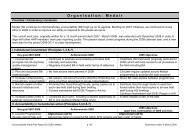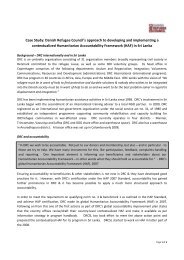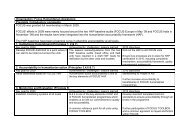Chapter Four - HAP International
Chapter Four - HAP International
Chapter Four - HAP International
Create successful ePaper yourself
Turn your PDF publications into a flip-book with our unique Google optimized e-Paper software.
THE 2008 HUMANITARIAN ACCOUNTABILITY REPORT<br />
17. Save the Children UK<br />
• Preparedness workshops will have sections on<br />
accountability<br />
• Project evaluations will have an evaluation<br />
question that looks at accountability systems,<br />
practices and procedures.<br />
• The new emergency projects (managed<br />
through and by the Emergency Section in<br />
Save the Children UK) will set up complaints<br />
mechanisms from the very beginning together<br />
with an M&E system to monitor their<br />
effectiveness and implementation.<br />
• Partnership MoUs for Emergency<br />
programmes 31 signed during 2008 will include<br />
a section on following mutually agreed<br />
humanitarian standards within the project.<br />
• We have standardized evaluation ToRs, where we<br />
request all emergency programme evaluations:“ to<br />
measure the extent to which the response has<br />
been accountable to the local needs of children and<br />
their families”. This has already been applied in at<br />
least 2 emergency responses: Myanmar and<br />
Swaziland.<br />
• We have established complaints mechanisms in<br />
Myanmar, continuously improved and changed<br />
them to meet the changing needs. Experience in<br />
Myanmar has been documented and will be used<br />
for further capacity building in other countries,<br />
including Zimbabwe in the nearest future.<br />
Lessons learned: Building capacity on accountability<br />
to beneficiaries at all levels helps to strengthen the<br />
quality of delivery, and is less frightening. When built<br />
in the culture of the organisation, with support from<br />
senior management teams, staff members find<br />
accountability to beneficiaries to be a fulfilling<br />
component of programme quality.<br />
3. Monitoring and Evaluation (Principle 5)<br />
Increase the extent of monitoring in programmes<br />
against accountability standards:<br />
• Have a strategy and plan for developing the<br />
HAF and furthering improvements, as well as<br />
monitoring and reporting against HAF mutually<br />
shared with a selected region.<br />
• The bar for M&E and requirements for better<br />
quality data for accountability standards will be<br />
increased in programmes in the targeted<br />
region for review and reporting.<br />
Achievements:<br />
• In the Myanmar response, accountability<br />
commitments were regularly measured through the<br />
existing M&E framework and systems. The M&E<br />
system was horizontally matched with the<br />
respective organisational chart where each<br />
management level took responsibility over a part of<br />
programme’s M&E. Impact in the Myanmar context<br />
was “the way beneficiaries valued our<br />
interventions”.<br />
31 Targeting emergency programmes managed by and through the Emergency Section<br />
32 MS-IRA – Multi-Sector Initial Rapid Assessment<br />
110<br />
• Work towards bringing the focus on children<br />
in our work when developing different<br />
reviews, feedback reviews.<br />
• Work with our emergency programmes to<br />
ensure feedback mechanisms are used, and<br />
feedback is acted upon.<br />
• Work towards enabling a global level regular<br />
monitoring of sector-specific outputs. Align<br />
existing information management<br />
mechanisms (like sitreps) with output<br />
tracking, that will also include feedback from<br />
beneficiaries.<br />
• Produce first drafts of guidelines on enabling<br />
accountability to children in first phase of<br />
emergency response.<br />
• Work towards testing the MS-IRA 32 in<br />
different contexts and improving the<br />
135


